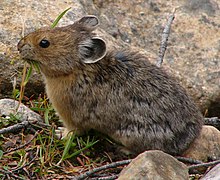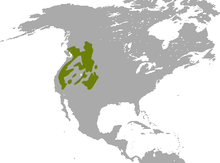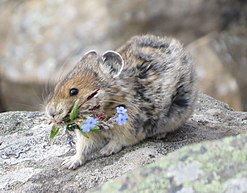| American pika[1] | |
|---|---|

| |
| An American pika feeding on grass in the Canadian Rocky Mountains | |
| Scientific classification | |
| Domain: | Eukaryota |
| Kingdom: | Animalia |
| Phylum: | Chordata |
| Class: | Mammalia |
| Order: | Lagomorpha |
| Family: | Ochotonidae |
| Genus: | Ochotona |
| Species: | O. princeps
|
| Binomial name | |
| Ochotona princeps (Richardson, 1828)
| |
| Subspecies[5] | |
|
O. p. princeps | |

| |
| American pika range | |

The American pika (Ochotona princeps), a diurnal species of pika, is found in the mountains of western North America, usually in boulder fields at or above the tree line. They are herbivorous, smaller relatives of rabbits and hares.[6] Pikas have two different ways of foraging; they either directly consume food or they cache food in piles for the winter (haying).
Pikas are vocal, using both calls and songs to warn when predators are nearby and during the breeding season. Predators of the pika include eagles, hawks, coyotes, bobcats, foxes, and weasels.
Recent studies suggest populations in the southwestern United States are declining due to habitat loss and global warming.[7] However, the American pika is overall considered a species of Least Concern, and is still common in the northwestern United States and Canada.
- ^ Hoffman, R.S.; Smith, A.T. (2005). "Order Lagomorpha". In Wilson, D.E.; Reeder, D.M (eds.). Mammal Species of the World: A Taxonomic and Geographic Reference (3rd ed.). Johns Hopkins University Press. pp. 191–192. ISBN 978-0-8018-8221-0. OCLC 62265494.
- ^ Jopling, A.V (1981). "Stratigraphic, Sedimentological and Faunal Evidence for the Occurrence of Pre-Sangamonian Artefacts in Northern Yukon". Arctic. 34 (1). doi:10.14430/arctic2499.
- ^ Smith, A.T.; Beever, E. (2016). "Ochotona princeps". IUCN Red List of Threatened Species. 2016: e.T41267A45184315. doi:10.2305/IUCN.UK.2016-3.RLTS.T41267A45184315.en. Retrieved 12 November 2021.
- ^ "NatureServe Explorer 2.0". explorer.natureserve.org. Retrieved 4 November 2022.
- ^ Hafner, David J.; Smith, Andrew T. (April 2010). "Revision of the subspecies of the American pika, Ochotona princeps (Lagomorpha: Ochotonidae)". Journal of Mammalogy. 91 (2): 401–417. doi:10.1644/09-MAMM-A-277.1.
- ^ "Pikas". World Wildlife Fund. Archived from the original on 9 May 2007. Retrieved 2007-05-15.
- ^ "Pikas Disappearing from Parts of the West Due to Climate Change | U.S. Geological Survey". www.usgs.gov. Retrieved 2023-04-15.

